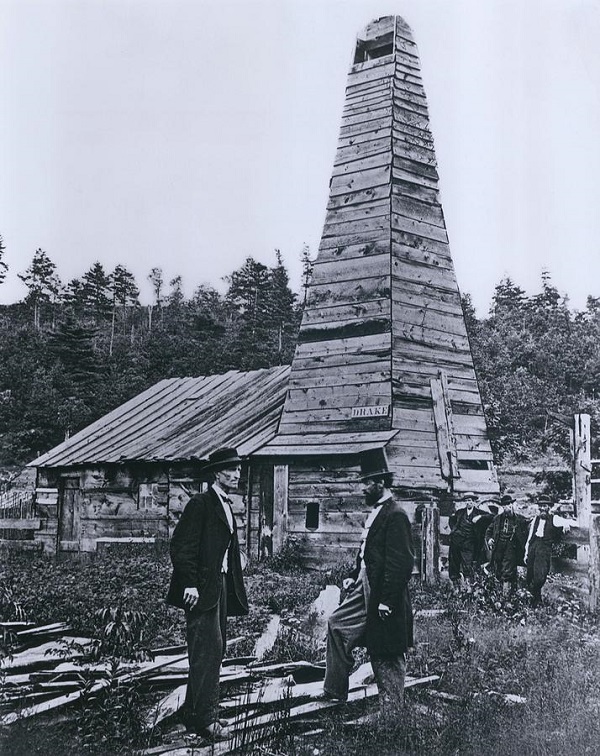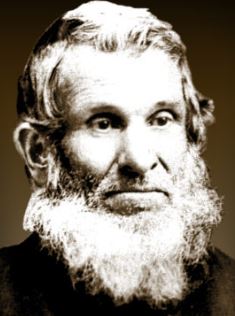Driller of first U.S. oil well accidently ignites it 41 days later.
Along Oil Creek at Titusville, Pennsylvania, the wooden derrick and engine house of the America’s first well specifically drilled for oil erupted in flames on October 7, 1859. The already famous well had been completed on August 27 by Edwin L. Drake, a former railroad conductor hired by the Seneca Oil Company of New Haven, Connecticut.

Edwin L. Drake, right, stands with friend Peter Wilson of Titusville, Pennsylvania, at the drilling site – but not the original derrick – of America’s first commercial oil well of 1859. From the Drake Well Museum collection.
Once called “Drake’s Folly,” the well discovered a shallow oilfield and launched the nation’s first drilling boom as refineries produced a popular, inexpensive lamp fuel, kerosene.
Residents of Titusville and nearby Oil City annually celebrate their 1859 oil well. Visitors to the Drake Well Museum and Park in Titusville tour a replica of Drake’s cable-tool derrick at its original location along Oil Creek.
“Uncle Billy” ignites First Well
The young U.S. oil and natural gas industry’s first conflagration began just 41 after Drake’s headline-making Pennsylvania discovery. The blaze reportedly began when his driller, a blacksmith named William “Uncle Billy” Smith, inspected the well’s oil production while holding a lamp.
“While Uncle Billy was successful in drilling the well, he was also responsible for the first oil well fire in the history of the oilfields,” according to a 2017 article by the Butler County Historical Society.
“He went to the well to inspect the oil in the vat, carrying with him an open lamp. That lamp set the gases alight, burned down the derrick, all the oil that was stored there, his home, and the engine house,” the society noted.

Edwin Drake’s driller, “Uncle Billy” Smith. Photo courtesy Butler County Historical Society.
Drake would will rebuild the derrick and engine house, which contained production equipment, including a boiler and six-horse power “Long John” engine purchased from the Erie Iron Works (also see Cool Coolspring Power Museum).
A famous image by oilfield photographer John Mather is often mistakenly identified as Drake and Smith standing in front of the historic derrick. In fact, it is Drake and his friend Peter Wilson, a Titusville druggist, standing in front of the second derrick.
To learn about another first — several of them, actually — in the new Pennsylvania oil regions, read The First Dry Hole.
The “father of the petroleum industry,” Edwin Drake, died in 1880. A Standard Oil Company executive commissioned a monument at Woodlawn Cemetery grave in Titusville. The monument, including a bronze statue by Charles Henry Niehaus, was dedicated on October 4, 1901.
Thousands of visitors today tour the replica cable-tool derrick and steam-engine house at Titusville’s popular oil museum, which also preserves thousands of photographs and artifacts from Pennsylvania’s “Valley that changed the World.”
Rouseville Well Fire
As Pennsylvania’s oil region continued to expand, drilling technologies raced to catch up. An oil well fire at Rouseville in 1861 brought added urgency for inventing new ways to make oil exploration safer.
A gusher had attracted people from the small Pennsylvania town and covered them in oil before before the well erupted in flames, killing 19 and seriously burning many others (learn about the oilfield tragedy in Fatal Rouseville Oil Well Fire of 1861).
After the Civil War, solid shot balls from cannons would be used for fighting oilfield tank fires.
_______________________
Recommended Reading: Western Pennsylvania’s Oil Heritage (2008); Myth, Legend, Reality: Edwin Laurentine Drake and the Early Oil Industry
(2009). Your Amazon purchase benefits the American Oil & Gas Historical Society. As an Amazon Associate, AOGHS earns a commission from qualifying purchases.
_______________________
The American Oil & Gas Historical Society preserves U.S. petroleum history. Become an AOGHS annual supporting member and help maintain this energy education website and expand historical research. For more information, contact bawells@aoghs.org. © 2022 Bruce A. Wells.
Citation Information – Article Title: “First Oil Well Fire.” Authors: B.A. Wells and K.L. Wells. Website Name: American Oil & Gas Historical Society. URL: https://aoghs.org/petroleum-pioneers/first-oil-well-fire. Last Updated: October 2, 2023. Original Published Date: April 29, 2013.


